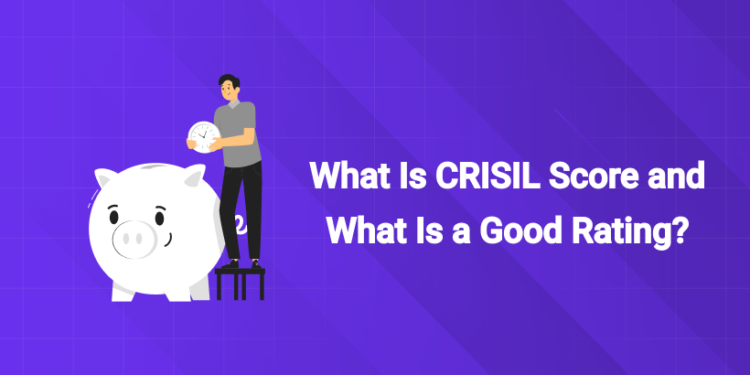Table of Contents
Introduction
In today’s fast paced financial world, trust and credibility play a huge role in lending and investment decisions. That’s where CRISIL Scores come in. CRISIL, short for Credit Rating Information Services of India Limited, is one of India’s most reputed credit rating agencies. It evaluates the financial health, creditworthiness and repayment ability of companies, institutions, and investment instruments.
Whether you are an investor looking for stable opportunities or a business looking for funding, understanding your CRISIL rating can make a big difference. A higher rating means lower risk and better financial management and a lower rating means red flags for lenders and investors.
In this blog, we will break down what the CRISIL Score means, what a good rating means, and how it impacts borrowing, investments, and trust in India’s financial ecosystem, all in simple and practical terms.
Learn Stock Marketing with a Share Trading Expert! Explore Here!
What is a “CRISIL Rating Score”?
1: What is a stock?
The term CRISIL Rating Score refers broadly to the assessment or rating given by CRISIL Ratings Limited (commonly called CRISIL) on the credit-worthiness of an issuer, instrument or business entity. In simpler terms, it is CRISIL’s opinion on how likely an entity or instrument is to meet its financial obligations (interest, principal, etc) in time.
In addition to that, CRISIL provides specialised assessment products such as its “Credit Assessment Score” for micro and small enterprises (MSEs) which is also a variation of the CRISIL Rating Score concept.
Why does it matter?
A good CRISIL Rating Score helps multiple stakeholders:
- For investors/lenders: It gives a quick, independent indication of risk. If you’re looking to invest in a bond or lending to a company, the CRISIL Rating Score gives you a benchmark.
- For issuers/companies: A favourable score means better access to credit, better borrowing terms, and greater trust from lenders and investors.
- For the market overall, It adds transparency and helps compare entities on a consistent scale, reducing asymmetric information.
Because of this, understanding what constitutes the CRISIL Rating Score and what is “good” becomes critical for both investors and companies.
How is the CRISIL Rating Score determined?
CRISIL assigns ratings using a detailed methodology that involves both qualitative and quantitative factors. Some key inputs include:
- Financial risk: debt levels, interest coverage, cash flows, and profitability.
- Business risk: industry conditions, competitive position, management quality, and strategy.
- Instrument characteristics: maturity, seniority, guarantees, structure (for example, structured finance) and other features.
- External environment: macro-economic factors, sectoral risks, and regulatory environment.
CRISIL uses alphanumeric symbols (like AAA, AA, A1, etc) under its rating scales. While the term “score” might suggest a numeric value, in many cases for credit ratings, it is more of a symbol reflecting a certain band of risk.
For MSEs, the CRISIL Credit Assessment Score (CCAS) is more clearly a “score” that compares the enterprise against peers.
Rating categories and scales
Here are some of the key rating categories and how the scale works for CRISIL:
Long-term ratings
For instruments or issuers with maturity of more than one year, CRISIL uses a long-term scale (for example: CRISIL AAA, CRISIL AA, CRISIL A, etc).
Short-term ratings
For instruments maturing within one year (like commercial paper, certificate of deposit), CRISIL uses a short-term scale (for example: CRISIL A1, A2, etc) and also “D” for default.
Structured finance/enhancements
Ratings of securitised instruments, credit enhanced instruments have suffixes like (SO) or (CE) and follow similar banding (e.g., CRISIL AAA(SO)).
Stock Market Training Reviewed & Monitored by SEBI Registered RA
Trusted, concepts to help you grow with confidence. Enroll now and learn to start investing the right way.
Know moreMeaning of the bands
- AAA: Highest safety regarding timely servicing of financial obligations.
- AA: Very high degree of safety.
- A: Adequate degree of safety.
- BBB / BB / B / C: Increasing degrees of risk. For example, instruments rated CRISIL B are said to carry high risk.
- D: Indicates the instrument is in default or expected to be.
So, when you see a CRISIL Rating Score in the form of “CRISIL AA+” or “CRISIL A1”, you should interpret it as being within that band of credit risk.
What counts as a good CRISIL Rating Score?
Since the CRISIL Rating Score is more about banding than a one-size numeric value, what is “good” depends on context (issuer type, instrument, risk appetite). But here are general guidelines:
- A rating of CRISIL AAA or equivalent: This is considered the best possible on CRISIL’s domestic scale. Indicates the highest level of safety among domestic issuers.
- Ratings in the AA band: Very strong, safe, though one notch below AAA. Many high-quality borrowers/instruments will sit here.
- Ratings in the A band: Adequate safety but more susceptible to adverse conditions compared to higher bands.
- Ratings of BBB or lower: Increasingly higher risk. For a risk-averse investor or lender, anything below A or AA may be considered less favourable.
- For short-term instruments: Ratings like CRISIL A1 are believed to represent a very strong ability to meet short-term obligations.
In short: If you’re looking for a good CRISIL Rating Score, aim for AAA or AA bands for high reliability. For less risk-averse or for higher yield-seeking investments, A band and below might be acceptable, but you must understand and accept more risk.
Additionally, the rating can have a “+” or “–” sign (for example, CRISIL AA+ or CRISIL AA–) to indicate relative standing inside that grade.
Also worth noting: Even the highest rating (AAA) doesn’t guarantee that there will be no default. CRISIL clearly states that ratings are opinions and the probability of default is non-zero.
How CRISIL Ratings Are Used in the Bond Market
The bond market is one of the primary places where CRISIL’s credit ratings are indispensable.
When companies, banks, or government entities issue bonds to raise money, investors want to know how safe these bonds are. This is where the CRISIL rating helps:
-
Investor Confidence – A high-rated bond (e.g., CRISIL AAA) assures investors that the issuer has strong repayment ability, making it a low-risk investment.
-
Interest Rate Determination – The higher the rating, the lower the interest rate the company has to offer. Conversely, lower-rated bonds carry higher yields to compensate for greater risk.
-
Market Liquidity – Bonds with strong CRISIL ratings are easier to trade in the secondary market.
-
Regulatory Compliance – Many mutual funds, banks, and pension funds are allowed to invest only in securities above a certain credit rating threshold (usually BBB or higher).
-
Benchmark for Performance – Investors often use CRISIL’s rating updates as indicators of a company’s changing financial health.
For example, if CRISIL downgrades a bond from AA to BBB, it may signal increasing risk, prompting investors to re-evaluate their holdings.
How do companies improve their CRISIL Rating Score?
For companies and issuers seeking a better CRISIL Rating Score, here are practical levers to focus on:
1. Strengthen financials
-
- Reduce the debt burden (especially high-cost debt)
- Improve interest coverage and cash flow generation
- Improve profitability and return on capital
- Reduce the debt burden (especially high-cost debt)
2. Improve business fundamentals
-
- Choose a robust business model with competitive advantage
- Maintain good industry positioning, diversify risks
- Robust management and governance
- Choose a robust business model with competitive advantage
3. Improve liquidity and structure.
-
- Keep working capital cycles efficient
- Have backup/flexibility for unforeseen adverse scenarios
- Use appropriate capital structure for the instrument (matching maturities)
- Keep working capital cycles efficient
4. Transparency and timeliness of information
-
- Provide full, reliable disclosures to CRISIL and stakeholders
- Avoid surprises (delays, defaults, major negative events)
- Provide full, reliable disclosures to CRISIL and stakeholders
5. Monitor external environment risks
-
- Be aware of regulatory changes, sector downturns, macro issues
- Have scenario planning and risk mitigation in place
- Be aware of regulatory changes, sector downturns, macro issues
By working on these fronts, a company or issuer can present a stronger case for a higher CRISIL Rating Score (i.e., moving to a higher grade band). Over time, improved financial and business metrics reflect positively in the agency’s assessment.
Mutual fund rankings, CCAS
a) Mutual fund rankings by CRISIL
While our main focus is on the credit-rating aspect, CRISIL also provides rankings for mutual funds. Here the scale is different: CRISIL assigns ranks from 1 to 5 (Rank 1 being top performers) based on risk-adjusted returns, asset quality, liquidity, etc.
This is slightly different from the traditional credit rating score, but it shows how CRISIL’s methodology extends beyond corporate debt to other financial products.
b) CRISIL Credit Assessment Score for MSEs
For Micro & Small Enterprises (MSEs), CRISIL’s “Credit Assessment Score” (CCAS) offers a scoring model rather than just a letter grade. It benchmarks an MSE’s risk and transaction history against peers.
If you are a small business or lender to one, understanding this variant of CRISIL Rating Score is important.
Methodology and risk of default
CRISIL emphasises that its ratings (and therefore the CRISIL Rating Score) are opinions on probability of default, not guarantees. They map domestic issuers against the sovereign benchmark (government of India) in their national scale.
Thus users of the rating must not treat it as an absolute risk-free stamp.
Learn Stock Marketing with a Share Trading Expert! Explore Here!
Key Takeaways
- The term CRISIL Rating Score refers to the assessment of credit-worthiness issued by CRISIL, either in letter grade format (AAA, AA, etc) or specific score formats (for MSEs).
- A good CRISIL Rating Score is generally within the AAA or AA band, indicating high safety of obligations.
- Ratings are based on detailed analyses of financial, business, structural, and external risk factors.
- Even high ratings do not guarantee zero risk; ratings express the relative risk of default.
- For issuers wanting better ratings, focus on clean finances, a strong business model, good governance, transparency, and risk management.
- While the CRISIL Rating Score mostly references credit ratings, CRISIL also issues mutual fund rankings (1-5) and assessment scores for smaller businesses, important if you’re into those segments.
Always use the CRISIL Rating Score as one tool in decision-making. It should not be the sole basis for investment or lending decisions.
Stock Market Training Reviewed & Monitored by SEBI Registered RA
Trusted, concepts to help you grow with confidence. Enroll now and learn to start investing the right way.
Know moreFrequently Asked Questions
What exactly does a CRISIL Rating Score of ‘CRISIL AAA’ mean?
It means that CRISIL considers the issuer or instrument to have the highest degree of safety with respect to timely servicing of financial obligations on a domestic scale. It indicates extremely low probability of default (relative to other rated entities) though not zero.
If a company has a CRISIL Rating Score of ‘CRISIL A’, can it be considered good?
“CRISIL A” indicates that the entity has adequate degree of safety to meet financial obligations, but it is more vulnerable to adverse business or economic conditions compared to higher rated entities. So, whether it is “good” depends on your risk tolerance and context.
Do CRISIL Rating Scores apply only to companies?
No. While many ratings are for companies and debt instruments, CRISIL also issues ratings for mutual fund schemes, MSE assessments (Credit Assessment Score), structured finance, credit-enhanced instruments etc.
How often does CRISIL revise its Rating Score?
Ratings are monitored on an ongoing basis and can change if CRISIL sees material changes in the credit profile of the issuer or instrument (financial deterioration, business shocks, structural changes). There may also be scheduled reviews.
Does a higher CRISIL Rating Score mean lower interest for borrowers?
Yes, generally a higher rating (better grade) suggests lower credit risk for lenders or investors, which often translates into lower borrowing cost or better terms for the issuer.
Can individual investors directly see the CRISIL Rating Score of a company?
Yes, ratings are published by CRISIL and typically available via the rated issuer’s disclosures, rating agency’s website, or other financial information portals. Investors can use them as a reference while analysing investment opportunities.
Can CRISIL Rating Score of a company improve if that company improves its financials?
Yes. If the company strengthens its business risk profile, improves cash flows, reduces debt, enhances liquidity, and reduces external risks, CRISIL may upgrade the rating on review. However, in a similar manner, negative changes may lead to a downgrade.
















